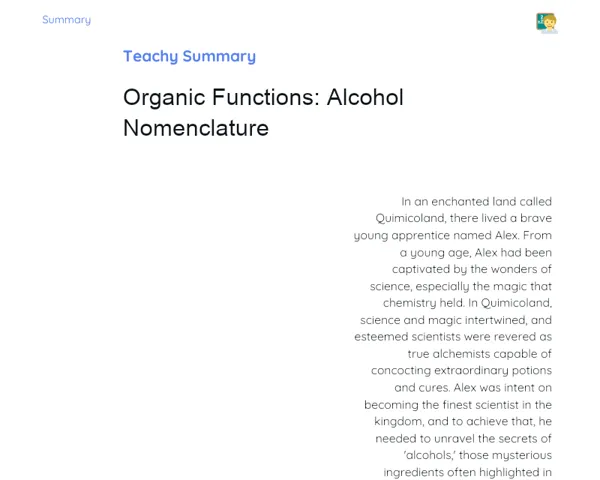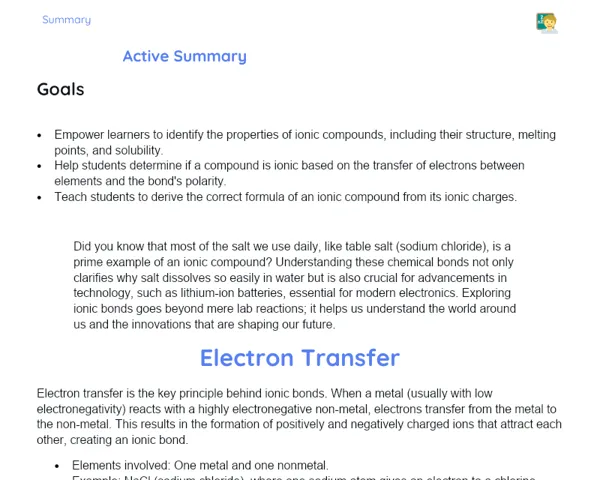Summary Tradisional | Organic Reactions: Substitution
Contextualization
Substitution reactions are a key area of organic chemistry, crucial for tweaking molecules and designing new compounds with particular characteristics. These reactions involve swapping out an atom or a group of atoms in a molecule with another atom or group, allowing for the transformation of substances into products that hold more value or utility. Over time, substitution reactions have found widespread use in things like drug development, making polymers, and various industrial applications, reflecting their practical significance and versatility.
Grasping substitution reactions is essential for any student of organic chemistry, as these reactions form the bedrock for many advanced chemical processes. Take for instance nucleophilic substitution (SN1 and SN2) and electrophilic substitution; these are critical mechanisms that permit the addition of functional groups into organic molecules, paving the way for the synthesis of diverse chemical compounds. Moreover, understanding the catalysts involved in these processes and the synthetic pathways leading to specific products is key to the innovation of new technologies and medicines. In this light, substitution reactions not only exemplify pivotal theoretical concepts but also spotlight practical uses that have a direct effect on our daily lives and industries.
To Remember!
Nucleophilic Substitution (SN1 and SN2)
Nucleophilic substitution reactions are one of the principal types of substitution reactions in organic chemistry. In the SN1 (Unimolecular Nucleophilic Substitution) reaction, the mechanism unfolds in two stages: first, a carbocation intermediate is formed after the leaving group departs, followed by the nucleophile attacking the carbocation. This reaction type tends to be preferred in tertiary substrates due to the stability of the carbocation.
Conversely, the SN2 (Bimolecular Nucleophilic Substitution) reaction occurs in a single go, where the nucleophile targets the substrate while the leaving group simultaneously exits. This reaction is favoured in primary and secondary substrates owing to their lower steric hindrance. The strength of the nucleophile and the type of solvent are critical factors for the success of the SN2 process.
Understanding the distinctions between SN1 and SN2 reactions is vital for predicting and managing the behaviour of chemical reactions in various scenarios.
-
SN1 reaction takes place in two steps involving the formation of a carbocation intermediate.
-
SN2 reaction occurs in a single step with a simultaneous attack by the nucleophile.
-
SN1 is preferred for tertiary substrates and SN2 for primary and secondary ones.
Electrophilic Substitution (SE)
Electrophilic substitution reactions are frequently encountered in aromatic compounds, where a π electron from the aromatic ring interacts with an electrophile. The typical mechanism involves creating an activated complex, where the electrophile temporarily attaches to the aromatic ring before the leaving group exits and aromaticity is restored.
A classic case of electrophilic substitution is benzene nitration, where a nitro group (NO2) gets added to the aromatic ring through a reaction with nitric acid in the presence of sulfuric acid. Another example is halogenation, where a halogen is integrated into the aromatic ring with assistance from a catalyst, like aluminum chloride (AlCl3).
The directing groups on the aromatic ring play a role in determining the substitution position. Activating groups, such as alkyl and hydroxyl groups, steer the substitution towards the ortho and para positions, while deactivating groups like nitro direct it to the meta position.
-
Electrophilic substitution reactions are common in aromatic compounds.
-
They involve forming an activated complex and restoring aromaticity.
-
Examples include nitration and halogenation of benzene.
Catalysts in Substitution Reactions
Catalysts are vital in substitution reactions, upping the reaction rate without getting consumed themselves. In nucleophilic substitution reactions, strong bases like NaOH are commonly used as catalysts to boost the nucleophile's reactivity, making it easier for it to attack the substrate.
For electrophilic substitution reactions, Lewis acids, such as AlCl3, are frequently employed. These catalysts work by enhancing the reactivity of the electrophile, facilitating its temporary affinity for the aromatic ring. For example, during benzene halogenation, AlCl3 assists in polarizing the halogen, increasing its electrophilic nature and readiness to react with the aromatic ring.
The role of catalysts is crucial for the efficacy of substitution reactions, enabling them to occur under milder conditions and with enhanced selectivity, which is especially important when synthesizing complex compounds where both selectivity and yield are critical.
-
Catalysts increase the pace of reactions without being consumed.
-
Strong bases like NaOH are used in nucleophilic substitution reactions.
-
Lewis acids like AlCl3 are used in electrophilic substitution reactions.
Synthetic Routes and Products of Substitution Reactions
Substitution reactions are integral in synthetic pathways for creating a host of organic compounds with industrial relevance. For instance, in drug synthesis, a series of substitution reactions can introduce specific functional groups that bestow therapeutic characteristics on the final product.
In polymer manufacturing, substitution reactions modify monomers, enabling the formation of polymers with tailored properties. One example is replacing hydroxyl groups with ester groups in the creation of polyesters, commonly used in fabrics and plastics.
Furthermore, substitution reactions are critical in the production of industrial chemicals, like pesticides and dyes. The ability to add different functional groups to molecules facilitates the synthesis of compounds with distinct properties and various applications.
-
Substitution reactions are leveraged in synthetic routes to create industrially relevant compounds.
-
Essential in drug production and modifying monomers for polymer creation.
-
Enable the addition of specific functional groups into molecules.
Key Terms
-
Substitution Reactions: Reactions where an atom or group in a molecule is exchanged for another atom or group.
-
SN1: Unimolecular Nucleophilic Substitution, occurs in two steps leading to a carbocation intermediate.
-
SN2: Bimolecular Nucleophilic Substitution, happens in one step with a simultaneous attack from the nucleophile.
-
Electrophilic Substitution: Reactions where a π electron from an aromatic ring interacts with an electrophile.
-
Catalysts: Substances that enhance the speed of reactions without being depleted.
-
Synthetic Routes: Planned sequences of chemical reactions to arrive at a specific final product.
Important Conclusions
Substitution reactions form a fundamental element of organic chemistry, enabling molecule modification and the generation of new compounds with specified properties. In this lesson, we delved into the mechanisms of nucleophilic substitution reactions (SN1 and SN2) and electrophilic substitution, illustrating their similarities and differences, the factors influencing these reactions, and real-world examples such as the nitration and halogenation of benzene.
We also touched on the critical function of catalysts in substitution reactions, noting how substances like Lewis acids and strong bases enhance the speed and efficiency of these reactions. Additionally, we discussed how these reactions are applied in synthetic routes for producing drugs, polymers, and other industrial chemicals, showcasing the practical and industrial significance of this knowledge.
Comprehending these mechanisms and their practical implications is vital for any chemistry student, as these reactions are prevalent in both industry and research. The insights gained about substitution reactions offer a robust foundation for innovating new technologies and products, and are also essential for the synthesis of complex organic compounds.
Study Tips
-
Refresh your understanding of SN1 and SN2 mechanisms, paying attention to structural differences and the various factors affecting each reaction type.
-
Examine practical instances of electrophilic substitution reactions in aromatic compounds, like nitration and halogenation of benzene, to solidify grasp of the underlying mechanisms.
-
Explore further the role of catalysts in substitution reactions and their applications in different industrial and laboratory settings.



